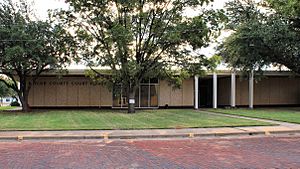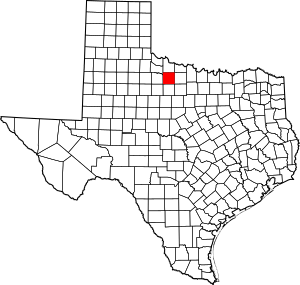Baylor County, Texas facts for kids
Quick facts for kids
Baylor County
|
|
|---|---|

The Baylor County Courthouse in Seymour
|
|

Location within the U.S. state of Texas
|
|
 Texas's location within the U.S. |
|
| Country | |
| State | |
| Founded | 1879 |
| Named for | Henry Weidner Baylor |
| Seat | Seymour |
| Largest city | Seymour |
| Area | |
| • Total | 901 sq mi (2,330 km2) |
| • Land | 867 sq mi (2,250 km2) |
| • Water | 34 sq mi (90 km2) 3.7% |
| Population
(2020)
|
|
| • Total | 3,465 |
| • Density | 3.8457/sq mi (1.4848/km2) |
| Time zone | UTC−6 (Central) |
| • Summer (DST) | UTC−5 (CDT) |
| Congressional district | 13th |
Baylor County is a county in the state of Texas. It's like a smaller region within a state. In 2020, about 3,465 people lived there. The main town and where the county government is located is Seymour.
Contents
History of Baylor County
Baylor County was created in 1858 by the Texas Legislature. This is the group that makes laws for Texas. The county was named after Henry Weidner Baylor. He was a doctor who worked with the Texas Rangers. This was during the Mexican–American War. The county officially started working in 1879.
Geography of Baylor County
Baylor County covers about 901 square miles. Most of this area is land. About 34 square miles, or 3.7%, is covered by water.
Main Roads in Baylor County
These are the important highways that go through Baylor County:
Neighboring Counties
Baylor County shares its borders with these other counties:
- Wilbarger County (north)
- Wichita County (northeast)
- Archer County (east)
- Young County (southeast)
- Throckmorton County (south)
- Haskell County (southwest)
- Knox County (west)
- Foard County (northwest)
Ancient Life in Baylor County
Baylor County is part of an area called the Texas Red Beds. These are layers of red rock that formed a very long time ago. This was during the Early Permian period, which was about 299 to 252 million years ago.
Scientists have found amazing fossils of ancient animals here. These include early amphibians like Trimerorhachis. They also found many fossils of other four-legged creatures called tetrapods. Famous examples include the Dimetrodon and Diadectes.
One special fossil found here is Seymouria baylorensis. This creature was named after Baylor County and the town of Seymour. It helps us learn about life on Earth millions of years ago.
People of Baylor County
| Historical population | |||
|---|---|---|---|
| Census | Pop. | %± | |
| 1880 | 715 | — | |
| 1890 | 2,595 | 262.9% | |
| 1900 | 3,052 | 17.6% | |
| 1910 | 8,411 | 175.6% | |
| 1920 | 7,027 | −16.5% | |
| 1930 | 7,418 | 5.6% | |
| 1940 | 7,755 | 4.5% | |
| 1950 | 6,875 | −11.3% | |
| 1960 | 5,893 | −14.3% | |
| 1970 | 5,221 | −11.4% | |
| 1980 | 4,919 | −5.8% | |
| 1990 | 4,385 | −10.9% | |
| 2000 | 4,093 | −6.7% | |
| 2010 | 3,726 | −9.0% | |
| 2020 | 3,465 | −7.0% | |
| U.S. Decennial Census 1850–2010 2010 2020 |
|||
In 2000, there were 4,093 people living in Baylor County. By 2020, the population was 3,465. This means the number of people living there has slowly decreased over time.
Most people in Baylor County are White. There are also people who are Black or African American, Native American, Asian, and Pacific Islander. Many people also identify as Hispanic or Latino. People from different backgrounds make up the community.
In 2000, about 25% of households had children under 18. More than half of the households were married couples. The average age of people in the county was 45 years old. This means there are many adults and older people living there.
Education in Baylor County
Most students in Baylor County go to schools run by the Seymour Independent School District. This school district also serves parts of nearby counties. A small part of the county is served by the Olney Independent School District.
For students who want to continue their education after high school, Vernon College serves this area.
Towns and Communities
City
- Seymour (This is the county seat, where the main government offices are.)
Unincorporated Communities
These are smaller communities that are not officially cities:
Images for kids
See also
 In Spanish: Condado de Baylor para niños
In Spanish: Condado de Baylor para niños


